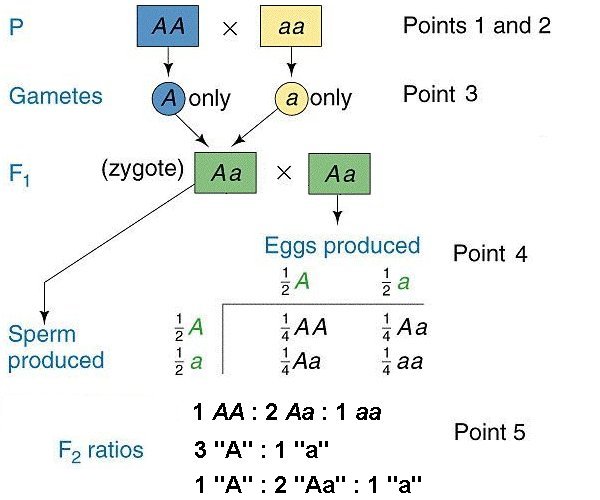
Primer
of Mendelian Genetics
The outward appearance of an organism (phenotype)
is influenced by its hereditary makeup (genotype).
Many Individual characters
(morphological,
behavioral, biochemical, molecular, etc.) of organisms may be determined more or
less
directly by individual hereditary elements called genes (which are made out of DNA). Genes are located on chromosomes,
each
at a particular physical location called a locus
(plural, loci).
Genetics is
the
business of analyzing phenotypes to infer the nature of their
underlying
genotypes. It is distinct from molecular biology, which analyzes genotypes (as written in the DNA) to predict phenotypes (which are frequently proteins). For this reason, molecular biology is sometimes called "reverse genetics."
1. Alternative forms of genes
are
called alleles; every individual
possesses
two alleles for each gene.
An individual with
two identical alleles is a homozygote and is described as
homozygous;
an individual with two dissimilar alleles is a heterozygote and is described as heterozygous.
For example, some
people can taste the chemical phenylthiocarbimide
(PTC).
The
character
"PTC sensitivity"
may be due to a gene
with two alleles,
one for "taster" and one for
"non-taster".
2. Some alleles (called dominant)
mask the phenotypic expression of other alleles (called recessive).
Dominant alleles are
symbolized with a capital letter (A)
&
recessive alleles with a lower-case letter (a).
For example, the "taster"
allele (T) may mask the "non-taster" allele (t):
a heterozygous Tt individual will show the "T"
phenotype ("taster").
Molecular
phenotypes
are typically the result of the expression of both alleles:
such alleles are called codominant.
3. The two alleles separate (segregate)
during the formation of gametes (eggs
& sperm) in meiosis;
half of the germs
cells carry one allele & half carry the other [Mendel's Law of
Segregation].
4. The random union of gametes
produces
zygotes
that develop into new individuals.
The zygotic
genotypes
will occur in characteristic ratios,
according
to the genotypes of the parents.
For example, a monohybrid cross
between two heterozygotes ( Aa x Aa )
produces an expected genotypic ratio of 1:2:1
among AA, Aa, & aa genotypes.
5. The
genotypic ratios produce characteristic phenotypic ratios,
according to the dominance relationships of the alleles involved.
For example, if A is dominant to a, the cross between
heterozygotes
produces
an expected phenotypic ratio of 3:1
among "A" and "a" phenotypes.
Co-dominant
molecular alleles typically produce a 1:2:1
ratio of "A", "Aa", & "a" phenotypes.
6. Alleles at separate loci are inherited independently [Mendel's Law of Independent Assortment]
This produces charactertistic genotypic and phenotypic ratios.
For example, a dihybrid cross between two "double heterozygotes" ( AaBb x AaBb )
The genotypic ratios are 1 : 2 : 1 : 2 : 4 : 2 : 1 : 2 : 1
and the phenotypic ratios are 9 "AB" : 3 "Ab" : 3 "aB" : 1 "ab"
7. Loci that occur on the same chromosome may not show independent assortment.
Such loci are said to be linked: the ratios will vary according to the distance between them
The ratios can be used to construct physical maps of chromosomes
Some loci are linked on the sex chromosomes and are described as sex-linked
Female mammals are XX: they have two alleles for any sex-linked locus
Male mammals are XY: they have a single allele for any sex -linked locus
X-linked genes are inherited in acharacteristic pattern that differs between sexes
Y-linked genes are expressed only in males
All text
material
©2006 by Steven M. Carr

